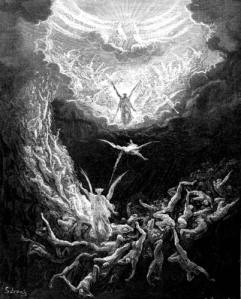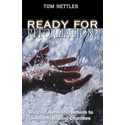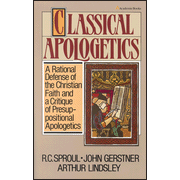Interpreting the Book of Revelation
 How many debates have you been in concerning the last book of the Bible? I imagine if you are compassionate about what you believe, then you may not be able to remember how many it has been. This is not necessarily bad. Christians ought to be passionate about God, his word, and things that accompany salvation. Nevertheless, Christians are also called to be good stewards of the word of God and to rightly divide the word of God 2 Timothy 2:15. Therefore we are going to take a look at the different schools of interpretation concerning the Book of Revelation.
How many debates have you been in concerning the last book of the Bible? I imagine if you are compassionate about what you believe, then you may not be able to remember how many it has been. This is not necessarily bad. Christians ought to be passionate about God, his word, and things that accompany salvation. Nevertheless, Christians are also called to be good stewards of the word of God and to rightly divide the word of God 2 Timothy 2:15. Therefore we are going to take a look at the different schools of interpretation concerning the Book of Revelation.
There are generally four main approaches to the book of Revelation that most Bible students use when studying this book. In other words, most consider themselves as falling into one of these four main camps of interpretation as a student of this book. These four main interpretational approaches are as follows:
Preterism
Historicism
Futurism
Idealism
We shall discuss each theological view of the Book of Revelation in the order that I listed them.
“The preterist: that it describes in veiled language events of John’s own time, and until the end of the Roman Empire or at least the conversion of Constantine. This has the disadvantage in that it is only meaningful then but to us it is not as relevant. The beast is seen as only the Roman empire and Babylon is Rome, however there are clear references to the Rome of John’s time and it is helpful to know the circumstances of John’s time in interpreting the book. In Rev 1: 11 John is told “Write on a scroll what you see and send it to the seven churches: to Ephesus, Smyrna, Pergamum, Thyatira, Sardis, Philadelphia and Laodicea.” hence in some ways it is similar to Paul’s letters to the Romans, Corinthians, Colossians, Ephesians and Thessalonians. In both John’s and Paul’s letters God has chosen these to be preserved for His church throughout the centuries. Just as the letter to the Corinthians addresses specific problems they had then it also deals with these problems for future centuries. In the same way Revelation deals with the problems faced by the seven churches in Asia, but it also has a great deal to say to future generations. Because John uses symbolic imagery Revelation is not tied down to only the Roman Empire but may also be used to describe successive persecuting tyrannies down through the centuries. Examples of the preterist view are Morris, Hailey and Barclay. Chilton identifies the destruction of Jerusalem in AD 70 as the main focus of Revelation.(1)
Historicism: that it is a chart of the whole of history from Christ’s first coming to his second, and beyond. In this method people will try to make sections of Revelation fit in with specific historical events. The beast is seen as the current manifestation of the beast such as the papacy in the time of the reformation. This position is untenable because there will be a wide variation of interpretations through the ages. But because the principles are valid to all generations, as the idealist would suggest, each generation should be able to identify the characters portrayed by Revelation. Therefore the historicist’s view should not be disparaged, it has provided comfort in times of persecution throughout church history. The most important of the historical interpretation from the 12th century to reformation times makes the papacy the beast and Rome or the Roman church is Babylon. However to make Revelation a chart of the whole of human history and therefore to use it to predict when the end will come is wrong and is not how John intended Revelation to be read, but to use it to strengthen God’s people undergoing particular trials is a valid use.(2)
The idealist: that between messages for the first century and prophecies of the far future it deals chiefly with principles that are always valid in Christian experience. The beast is the Roman Empire of John’s day but also a succession of ungodly empires leading to the last empire from which the antichrist will come. Because Christians have been persecuted throughout the generations, each generation should be able to identify who their beast is. The main example is Hendriksen, see also Beale and Wilcock.(3)
The futurist: that it is largely a prophecy of events still to come, especially just prior to the return of Christ. This is the normal interpretation of someone reading the book for the first time because its imagery looks so fantastic. It means that the book will be especially relevant for those in the last generation. The beast is seen as the antichrist who emerges from a revived Roman empire. It is clear that the Second Coming features prominently throughout the book and therefore there is truth in the futurist view, but this view tends to overlook spiritual truth that is of value today. However note that John is told not to seal up the book (Rev 22:10) because the time is near, although Daniel was told to seal up the vision until the end times (Dan 12:4), this means that the book is about to start its fulfilment. The book of Revelation was written initially to the seven churches in Asia, and hence the preterist view. However the book will reach it final fulfilment when the last antichrist appears and Christ returns this is the futurist view.
Ladd divides the futurist views into two kinds, the moderate and the extreme view known as dispensationalism. The latter makes a sharp distinction between Israel and the church. The letters to the seven churches deal with seven ages of church history. Chapter 7 onwards concerns Israel because the church has been raptured by this point so that it does not suffer in the great tribulation, which occurs during the last 3 and a half years of history. This view is widely held in America, the best exponent of this view is Walvoord.”(4)
The only view that does justice to this book is the view held by the Idealists. This is because those holding this view allow the book to speak to the entire Church throughout the whole church age. All the other views tend to restrict this book to only a certain group or generation of peoples.
There is another method that not many employ when studying this book. Though it leans towards the Idealist camp, nevertheless it seeks to exegete the book in the historical context of which it was written and then makes it applicable to the entire Church age. In other words, this view approaches the study of the book by exegeting it in the historical context in which it was written, while recognizing that the entire Church age will always be dealing with the Beast and Christians will aways suffer persecution and martyrdom. This is called the Inductive method.
This view also sees the book as seven visions that use a ‘progressive parallelism’ grid as the visions build upon one another. This method is quite common throughout the Bible. God gives a general account of the creation in Genesis 1 and then recounts the creation in chapter 2, while adding greater detail.
Here is a brief outline of the progressive “parallelism method:”
“The system of interpretation of the book of Revelation which seems most satisfactory to me (though it is not without its difficulties) is that known as progressive parallelism, ably defended by William Hendriksen in More Than Conquerors, his commentary on Revelation.(5) According to this view, the book of Revelation consists of seven sections which run parallel to each other, each of which depicts the church and the world from the time of Christ’s first coming to the time of his second. The first of these seven sections is found in chapters 1-3.
John sees the risen and glorified Christ walking in the midst of seven golden lampstands. In obedience to Christ’s command John now proceeds to write letters to each of the seven churches of Asia Minor. The vision of the glorified Christ together with the letters to the seven churches obviously form a unit. As we read these letters we are impressed with two things.
First, there are references to events, people and places of the time when the book of Revelation was written. Second, the principles, commendations and warnings contained in these letters have value for the church of all time. These two observations, in fact, provide a clue for the interpretation of the entire book. Since the book of Revelation was addressed to the church of the first century A.D., its message had reference to events occurring at that time and was therefore meaningful for the Christians of that day. But since the book was also intended for the church through the ages, its message is still relevant for us today.
The second of these seven sections is the vision of the seven seals found in chapters 4-7. John is caught up to heaven and sees God sitting on his radiant throne. He then sees the Lamb that had been slain taking the scroll sealed with seven seals from the hand of the one who was sitting on the throne. The various seals are broken, and various divine judgments on the world are described. In this vision we see the church suffering trial and persecution against the background of the victory of Christ.
The third section, found in chapters 8-11, describes the seven trumpets of judgment. In this vision we see the church avenged, protected and victorious.
The fourth section, chapters 12-14, begins with the vision of the woman giving birth to a son while the dragon waits to devour him as soon as he is born—an obvious reference to the birth of Christ. The rest of the section describes the continued opposition of the dragon (who stands for Satan) to the church. This section also introduces us to the two beasts who are the dragon’s helpers: the beast out of the sea and the beast out of the earth.
The fifth section is found in chapters 15-16. It describes the seven bowls of wrath, thus depicting in a very graphic way the final visitation of God’s wrath on those who remain impenitent.
The sixth section, chapters 17-19, describes the fall of Babylon and of the beasts. Babylon stands for the worldly city — the forces of secularism and godlessness which are in opposition to the kingdom of God. The end of chapter 19 depicts the fall and final punishment of the dragon’s two helpers: the beast out of the sea, and the false prophet, who appears to be identified with the beast out of the earth (see 16:13).
The seventh section, chapters 20-22, narrates the doom of the dragon, thus completing the description of the overthrow of the enemies of Christ. In addition, it describes the final judgment, the final triumph of Christ and his church, and the renewed universe, here called the new heaven and the new earth.(6)
It is here that I point you to an entire sermon series that uses this method and it consists of 81 lectures or sermons on this book. This sermon series is taught by Arturo G. Azurdia and can be found right here.
1. Taylor, R. A., (Copyright 2000) pg. 14 (online-at: http://www.thefishersofmenministries.com/revelatn.pdf)
2. ibid., pg. 15
3. ibid., pg. 15
4. ibid., pg. 15
5. William Hendriksen, More Than Conquerors (Grand Rapids: Baker Book House, 1939). An exposition and defense of this method of interpretation, summarized in nine propositions, can be found on pp. 11-64.
6. Amillennialism: Part I – Introduction by Anthony Hoekema (online-at: http://www.graceonlinelibrary.org/eschatology/amillennialism-part-i-introduction-by-anthony-hoekema/ )












Recent Comments